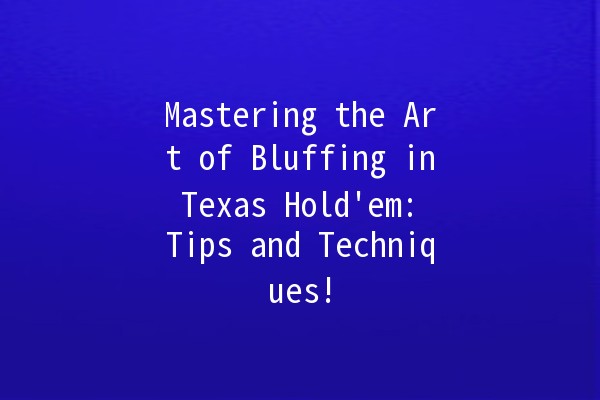Bluffing is a crucial aspect of poker, particularly in Texas Hold'em, where strategic deception can lead to significant victories. Understanding how to effectively execute a bluff can elevate your game, allowing you to manipulate opponents and seize control of the table. Here, we’ll explore practical techniques, offering actionable tips that you can implement right away.
The Importance of Reading Players
To bluff successfully, knowing your opponents is essential. Pay attention to their playing styles and tendencies. Are they aggressive or passive? Do they fold easily to bets, or do they call with marginal hands? This information is critical when deciding whether to bluff.
How to Read Your Opponents:

Observe Betting Patterns: Note how much your opponents bet in different situations.
Identify Psychological Cues: Look for physical tells, like nervousness or confidence.
Use Position to Your Advantage: Bluff more when you're in a late position, where you have more information about how your opponents have acted.
Example in Practice
Imagine you’re at a table with a player known for their tight play. After the flop, they hesitate before checking, giving you an opportunity to bluff aggressively. A sizable bet could convince them to fold, especially if the board has scary cards that could complete draws.
Timing is Everything
Choosing the right moment to bluff can significantly impact its success. Ideally, you want to bluff when the situation appears favorable (or unfavorable) to your opponent.
Optimal Situations:
Scary Board Cards: If the community cards are such that they likely benefit a strong hand (like a flush or straight), your bet might be perceived as a genuine attempt to take down the pot.
Weak Players: Bluffing against players who are prone to folding can yield higher success rates.
Example in Practice
You’re holding a single high card, but the community cards show a potential straight. If you bet big enough, you can make it appear as though you’ve hit your draw. If your opponent is cautious, they may fold even a decent hand, increasing your chances of winning.
The Power of Bet Sizing
The size of your bet can signal strength or weakness. A welltimed bluff often entails varying the size of your bet based on the context.
Key Considerations:
Bigger Bets for Serious Bluffing: A large bet can intimidate your opponents into believing you have a powerful hand.
Small Bets for Subtlety: A smaller bet can provoke an opponent into calling, allowing you to gauge their strength.
Example in Practice
On the river, you hold a mediocre hand. The pot is $100, and you bet $
Crafting Your Narrative
Every action in poker contributes to a story that you’re telling your opponents. Consistency is crucial to not raise suspicion.
Building Your Bluff:
Preflop Play: If you raise preflop, ensure that your actions postflop match that aggression.
Consistent Actions: If you were betting aggressively on earlier streets, follow through on later streets for your story to remain believable.
Example in Practice
Say you raise preflop, and the flop comes out favorably. By continuing to bet as if you’re holding a strong hand, you reinforce the narrative that you are not bluffing. If opponents have seen you play similarly before, they may be more likely to buy into your story.
Your Image at the Table
Your table image plays a significant role in how effective your bluffs will be. If you’ve been playing conservatively, your bluffs will be more believable when they occur.
Managing Your Image:
Establish a Strong Playing Style: Build your image through solid play to create a reputation for being tight or aggressive.
Flip the Script Occasionally: If your image is overly tight, include some bluffs to shake things up and keep opponents guessing.
Example in Practice
If you’ve played only strong hands for the past few rounds, opponents might assume you always have a premium hand. This reputation can lend significant weight to a welltimed bluff, as they may respect your apparent strength and fold weaker hands even when they are behind.
Frequently Asked Questions
Q1: What types of bluffs are commonly used?
A1: Common bluffing strategies in poker include the pure bluff, where you represent a strong hand when you have none, and the semibluff, where you bet on a hand that may improve. Each type has different strategic implications and should be used depending on the situation.
Q2: When should I avoid bluffing?
A2: Avoid bluffing against players who are known to call frequently with weak hands, or in situations where the odds are stacked against you. Additionally, steer clear of bluffing in lowstakes games, where players tend to be less disciplined.
Q3: How can I improve my bluffing skills?
A3: The best way to improve is through practice. Join various games and experiment with bluffing in different situations. Analyzing past games and understanding your results will also help refine your technique.
Q4: Is it advisable to bluff in tournaments?
A4: Yes, bluffing can be a critical part of tournament strategies. As the stakes rise and players become tighter, strategic bluffs can help you maintain a healthy chip stack. Just remember to assess your opponents' tendencies carefully.
Q5: How can I spot when someone else is bluffing?
A5: Look for inconsistencies in betting patterns. If a player suddenly bets aggressively without much prior action, it could signal a bluff. Observing physical tells or reactions can also assist in making these determinations.
Q6: What is the psychological aspect of bluffing?
A6: Bluffing is as much about psychology as it is about cards. The ability to read opponents' emotions and behaviors can lead to successful bluffs. Cultivating a calm demeanor can also enhance your effectiveness while bluffing.
Bluffing in Texas Hold'em is both an art and a science. By understanding your opponents, strategically timing your moves, and maintaining a consistent narrative, you can enhance your overall performance at the table. Engage with these techniques, refine your skills, and watch your game thrive!